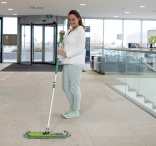Home › magazine › june july 2025 › latest news › Modern mopping easing the strain
Modern mopping - easing the strain
14th of October 2024The manual task of mopping can take its toll on the arms, backs and shoulders of the operator. Why, then, do so many businesses still use this traditional cleaning method, asks Ann Laffeaty? And what are manufacturers doing to ease the physical strain on the cleaner?
Mopping can be hard work. It requires bending, stooping and stretching – all actions that can cause physical problems on the part of the operator. This floor-cleaning method is also fairly dated, having been around for well over a century. The mop as we know it was patented in the US in 1893 by Thomas Stewart who invented a clamping device that could be used for wringing.
However, with increasing levels of technology and automation available today, the need for people to put themselves through the physical stress of manual mopping has been reduced. So, what are the best and most viable alternatives to the traditional mop? And what are manufacturers doing to ease the task of mopping for the operative?
There is no denying the fact that mopping can be fairly stressful in terms of effort, says Kärcher’s business development manager Beyza Gügercin. “This is the case with any type of manual labour,” she adds. “However, the latest tools, systems and mopping technologies have all been designed to assist operators in their daily work.”
Musculoskeletal disorders are among the most common conditions associated with manual mopping, she said. “Cleaners may develop problems with their muscles, nerves, tendons, joints, cartilage and spinal discs, while carpal tunnel syndrome is another common issue.”
However, manual mopping continues to be widely carried out because it is an easy solution, she says. “Anyone can mop a room with decent results without having received much training, and a mop can be used in areas that are beyond the reach of machines such as in confined spaces and on staircases,” says Gügercin.
Another advantage of mops is that they are always readily available, she adds. “It is a quick process to grab a mop and clean an area with a spray applicator and a microfibre head, which will ensure a quick dry,” she said. “And manual mops require no power source which makes them particularly sustainable because they are ‘human-operated’.”
Microfibre mops have the further advantage of helping to reduce the consumption of water and detergent, according to Gügercin. “They are also a cost-effective option in terms of initial investment while still producing high levels of performance,” she said.
However, she believes that ergonomics need to play a crucial role in mopping. “A mop should be lightweight, durable and easy to use while also providing a good performance and gliding smoothly over the floor,” she said. “At Kärcher we the pay particular attention to usability and ergonomic handling by cleaning staff when developing our products.”
Kärcher’s Infinity system features a handle with an ‘S’-shaped join which is said to allow the operator to mop faster while also reducing the number of wrist movements required. The company also offers the Flexobox, a mop box that can be opened and closed with the foot to avoid the need for bending.
Physical discomfort
Cleaners are liable to experience physical discomfort when mopping if they adopt improper techniques or incorrect postures, according to Greenspeed’s marketing executive Rosaliene Verhoef.
“This is why it is so important they always maintain a straight back while mopping and they ensure the handle is of the correct length, which means it should reach up to nose height,” she said. Cleaners should also avoid using excessively wide strokes when mopping and adopt a ‘Z’ motion rather than an ‘S’ motion, she adds.
“The ‘Z’ motion involves shorter, more controlled movements that minimise the twisting and turning of the wrist,” she said. “This technique engages larger muscle groups in the arms and shoulders and distributes the effort more evenly, reducing the risk of repetitive strain on the smaller muscles and joints of the wrists.”
But despite their potential to cause aches and pains, mopping systems deliver effective results, she adds. “Mops can reach into even the smallest corners and crevices ensuring a thorough clean without requiring a significant investment.
“Mopping is also versatile and can be used on a wide range of floor surfaces without any concerns about equipment compatibility or potential floor damage. It is also often more practical in restricted spaces and in places where there are numerous obstacles. And it provides added convenience in locations where machine storage just isn’t feasible.”
Manufacturers can play a key role in helping to ease the task for the operator, Verhoef believes. “They can introduce ergonomic designs, for example, along with handles that make it easier to attach and remove mop heads without having to bend over or directly handle the mop.
“Developing mops with a high cleaning power but with minimal floor friction also helps. And the cleaning process can be further simplified by ensuring the operator has an adequate supply of mops and washing facilities without the need for wringing and rinsing with a wringer.”
Greenspeed’s Click’M C system has a magnetic locking mechanism that allows for hands-free operation, which is said to reduce the need for bending and manual handling. The company claims its Hydra cleaning system is both lightweight and easy to use with an ergonomic design that is said to reduce the need for physical effort. And this can help to prevent the aches and pains in the arms, back, and shoulders that are commonly associated with traditional mopping, according to Greenspeed.
Repetitive motion, bending and twisting are all actions that can lead to physical problems when mopping, says service provider Cleanology’s Kate Lovell. “There is also the risk of strain to the arms and shoulders when the operator is forcefully scrubbing particularly dirty areas or wringing out heavy mops,” she adds. “However these issues can be avoided by using a lightweight mop with adjustable handles and by adopting a good posture while also remembering to take regular breaks.”
Other conditions associated with mopping include tendonitis, RSI, lower back pain, tennis elbow, knee problems and foot and ankle strains, she says.“However, many businesses stay loyal to this traditional cleaning technique for various reasons including the low cost of equipment and the fact that little training is required,” says Lovell. “Cleaning machines may also require regular servicing and can be costly to repair if they break down. And manual mops are ideal for use in hard-to-reach areas that floor scrubbers may not be able to access.”
Another advantage of manual mopping is that it permits operatives to clean thoroughly around corners, edges and other obstacles that machines may struggle to reach, she says. “Any urgent cleaning of spills and stains may be tackled straight away with a mop, and there are none of the set-up or warm-up periods associated with a machine,” said Lovell. “They are also better suited to noise-sensitive environments such as schools and hospitals and require minimal storage space.”
Musculoskeletal disorders affect a high percentage of cleaners and are a leading cause of absences from work, says Filmop’s business development manager Paolo Scapinello.
Severe consequences
“The onset of these conditions may be linked to the repeated execution of movements that require effort,” he said. “They could also be the result of excessive extension caused by certain tasks and by adopting a poor posture for prolonged periods.
“And they can lead to severe consequences not only for workers, who will experience physical suffering and a decrease in wellbeing, but also for employers who will have to manage staff absences and bear the corresponding costs.”
However, musculoskeletal disorders can be avoided with the use of ergonomic equipment and adopting correct procedures, he says. Filmop’s Boost wringer is said to remove the need for exerting intense and repetitive strain while the ErgoSwing is claimed to allow the operator to maintain the correct posture when cleaning.
Mops offer several advantages despite their pitfalls, according to Scapinello. “Their compact size facilitates cleaning in narrow aisles, around obstacles and under furniture,” he said. “And the fact that mops are easier to use than machines reduces the amount of staff training time required.”
Manufacturers can help to ease the strain of mopping by providing ergonomic equipment, he says. “Our research and development department is constantly engaged in designing new systems that are engineered to avoid strains, prevent the need for continuous bending and discourage a poor posture,” says Scapinello.











